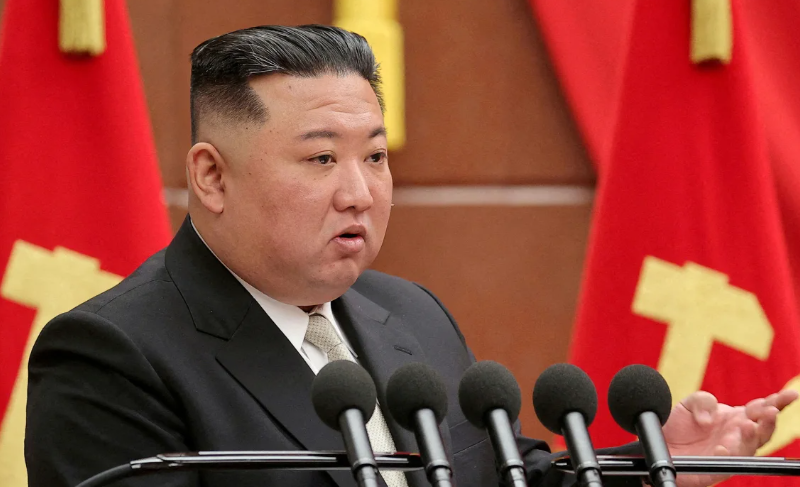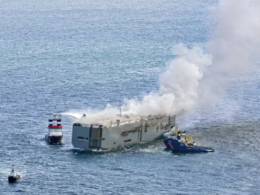North Korea says it failed at launching a satellite and will try again. The second stage of the rocket North Korea was using to launch a military reconnaissance satellite failed mid-flight on Wednesday, according to the state-run Korean Central News Agency (KCNA), which also reported that Pyongyang planned to conduct a second launch as soon as possible.
KCNA said that the new satellite vehicle rocket Chollima-1 had crashed into the West Sea after losing propulsion after the 1st stage had been detached during a routine flight.
According to the study, the mission’s failure was due to “the reliability and stability of the new engine system” being “low” and the fuel utilized being “unstable.”
Read more: Venice’s Grand Canal’s bright green material has been discovered.
The North Korean National Space Development Agency claimed they would “urgently” analyze the failure and try again after more testing, as reported by KCNA.
At 8:05 a.m., the South Korean Joint Chiefs of Staff reported locating an object in the sea about 200 kilometers (125 miles) west of Eocheong Island, which is believed to be a piece of what North Korea claims to be its space launch vehicle.
Weeks after North Korean leader Kim Jong Un instructed authorities to prepare to launch the country’s first military reconnaissance satellite, the South Korean military said Pyongyang fired a “space projectile,” setting off emergency alarms in Seoul and Japan.
Both governments deactivated the notifications when it became evident that there was no threat to civilian areas from the North Korean launch.
Events on Wednesday morning, analysts said, exemplified difficulties for both North and South Korea in their respective space programs and public alert systems in Seoul.
According to Malcolm Davis, a senior analyst at The Australian Strategic Policy Institute, the repeated failure of North Korea’s space programs suggests that the country’s space launch capabilities are not progressing at the same pace as its military missile capabilities.
Davis remarked, “That is curious because space launch capabilities and ballistic missile systems are similar technologies in many respects. North Korean testing of ballistic missile systems has been more successful.”
Yoo Sang-bum, a member of the ruling party in South Korea, told reporters on live TV that the country’s spy agency believes the launch on Wednesday may have failed in part because North Korea rushed preparations and sought to change the flight course.
Yoo told reporters that the NIS believes Kim Jong Un saw the launch attempt from approximately 1.3 kilometers from the Tongchang-ri site.
Yoo claimed the North Korean satellite had an estimated length of 1.3 meters (4.3 feet), a mass of 300 kilograms (661 pounds), and a resolution of no better than 1 meter for essential reconnaissance missions. According to [the NIS], this rocket is a new projectile built around an intercontinental ballistic missile engine, the congressman stated.
Yoo stated that the NIS estimates it will take North Korea at least two weeks to prepare for a second launch, however, this time frame could be reduced if the problems are not severe.
Over the past two years, North Korea has conducted dozens of ballistic missile tests, leading some experts to conclude that the country’s missile program has evolved.
Analysts believe Pyongyang could respond more rapidly to a nuclear conflict thanks to the successful April test of a new solid-fueled intercontinental ballistic missile (ICBM).
About 6:30 a.m., after the North Korean launch, air raid sirens began sounding around Seoul, causing bewilderment among locals accustomed to midday warning system tests.
A text message was then sent to mobile devices informing individuals to be ready to seek shelter as the sirens wailed.
The alarm was turned off about 20 minutes after it was first issued.
Who exactly activated the warning is a mystery. According to the Interior Ministry, the Seoul municipal administration incorrectly published it.
The mayor of Seoul, Oh Se-hoon, has apologized to the public for “causing confusion” by issuing a citywide notice and promised to work to improve the system.
According to Professor Leif-Eric Easley of Seoul’s Ewha Womans University, any criticism of government authorities for the alarm may be unjustified.
Easley argued that if the government did not ensure public safety, it would face increased criticism.
He even said that the warning would wake South Koreans to the real threat of Pyongyang’s missile development.
Easley predicted that the Yoon administration would boost public awareness of the North Korean danger to bolster support for the government’s military deterrent measures.
The South Korean and Japanese governments deemed North Korea’s launch a breach of UN Security Council resolutions.
According to a statement released by Yoon’s office, “whether it was a success or not (it was) a serious provocation that threatens peace and security on the Korean Peninsula and the international community.”
Hirokazu Matsuno, the head of Japan’s cabinet, said the country has “vehemently protested” to North Korea. He assured the public that the Japanese government would maintain its “vigilance and surveillance” indefinitely.
On Monday, when Pyongyang informed Japan of preparations to launch a “satellite,” the Japanese Ministry of Defense warned that it would destroy any missile that penetrated Japanese territory.









